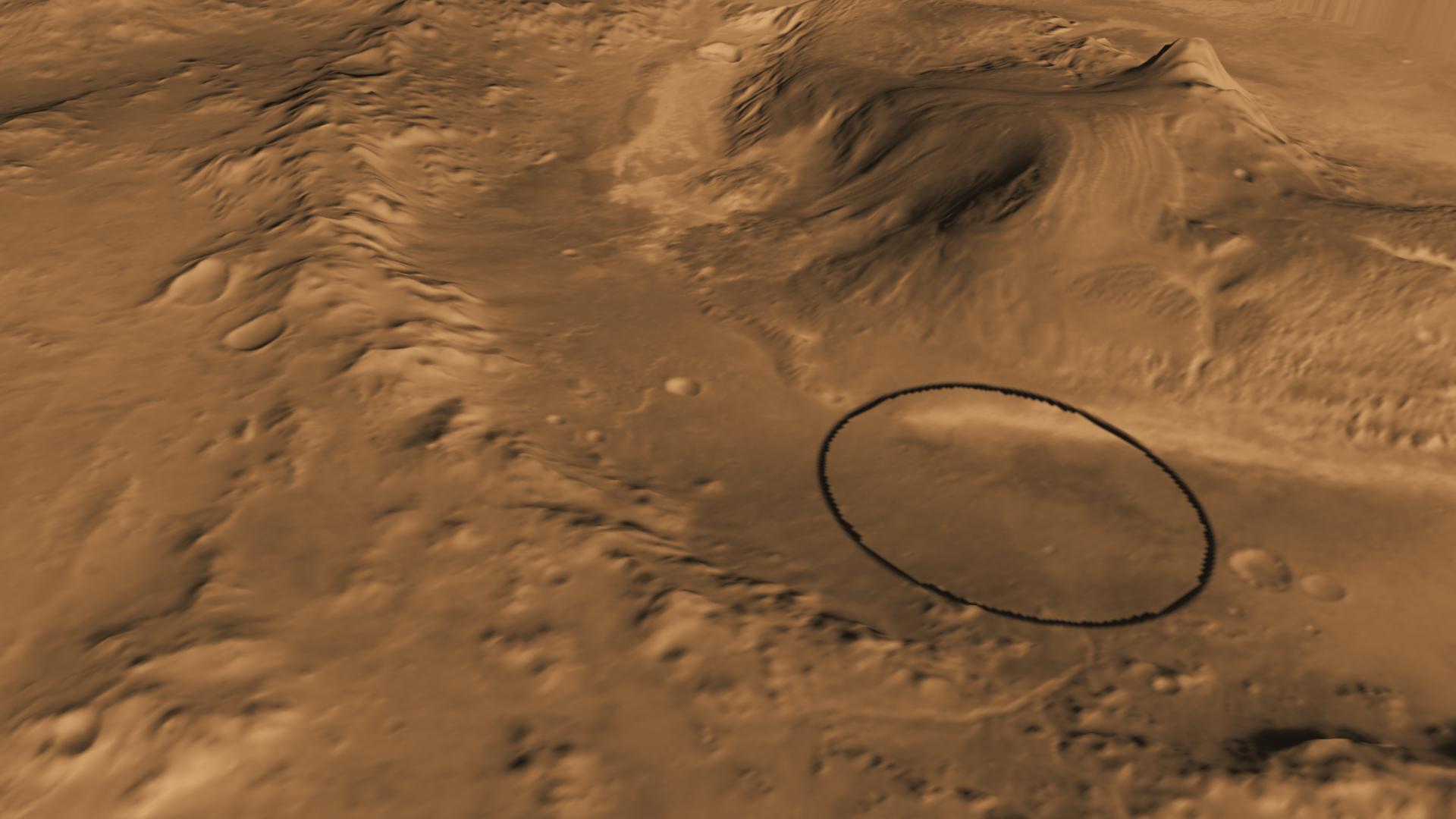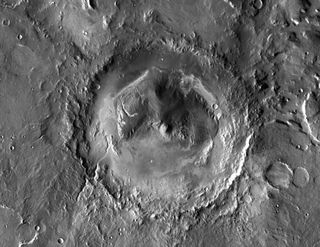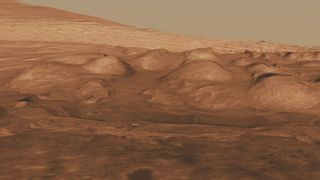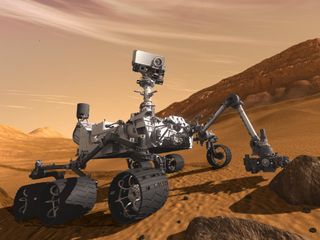NASA's Next Mars Rover to Land at Huge Gale Crater

This story was updated at 12:45 p.m. EDT.
WASHINGTON — It's official: NASA's next Mars rover has a landing site, and it's a giant crater called Gale.
NASA's $2.5 billion Mars Science Laboratory (MSL) mission is slated to launch in late November, and will drop a car-size rover named Curiosity at the Gale crater.
"We are going to the mountain at Gale crater," Michael Watkins, project engineer for the Mars Science Laboratory at the Jet Propulsion Laboratory (JPL) in Pasadena, Calif., revealed in a press conference today (July 22). "It exhibits three different kinds of environmental settings, perhaps the trilogy of Mars history. It's a worthy goal, a worthy challenge for such a capable rover."
Gale crater is about 96 miles (154 kilometers) wide and has a mountain at its center that rises higher, from the crater floor up, than Mount Rainer near Seattle. The crater, which is named after Australian astronomer Walter F. Gale, is so large that the U.S. states of Connecticut and Rhode Island could fit inside it, NASA officials said. [Video: Fly Over Gale Crater on Mars]
"Mars is firmly in our sights," NASA Administrator Charles Bolden said in a statement. "Curiosity not only will return a wealth of important science data, but it will serve as a precursor mission for human exploration to the Red Planet."

Gale crater is also thought to harbor clues of ancient water activity on the Martian surface, and one of Curiosity's primary tasks will be to root around for evidence that Mars is, or was, capable of supporting microbial life. [Gale Crater FAQ: Mars Landing Spot for Next Rover Explained]
Get the Space.com Newsletter
Breaking space news, the latest updates on rocket launches, skywatching events and more!
"Scientists identified Gale as their top choice to pursue the ambitious goals of this new rover mission," said Jim Green, director for the planetary science division at NASA Headquarters in Washington, in a statement. "The site offers a visually dramatic landscape and also great potential for significant science findings."
The agency revealed the landing site today (July 22) in a briefing hosted by the Smithsonian National Air and Space Museum in Washington. The announcement coincides with the museum's celebration of Mars Day, which commemorates the 35th anniversary of NASA's Viking 1 Mars landing on July 20, 1976.
The next Mars landing
During a series of worldwide workshops, members of the science community proposed 60 potential landing sites, said John Grant, a geologist at the National Air and Space Museum in Washington, D.C. [Best (And Worst) Mars Landings in History]
In 2008, four primary candidates were selected, and eventually two finalists were identified: Eberswalde crater and Gale crater.

Eberswalde is largely considered one of the best deltas on Mars, and at some point, the crater was likely filled with water, Grant said. Each of the candidate sites "represent an incredible opportunity for MSL. It was a very difficult decision to arrive at a final one," he said.
Targeted images from the Mars Reconnaissance Orbiter, which has been circling the Red Planet since 2006, provided detailed imagery of the potential landing sites that enabled scientists and engineers to evaluate safety concerns and the scientific benefits of each candidate location.
A team of senior NASA officials, principal investigators and co-investigators then conducted a thorough review and unanimously selected Gale crater as the official landing site.
"All four of the final sites were really great candidates," Grant told SPACE.com. "Early on in the process, I had a favorite. I can honestly say that that went away. They're really different. With Gale crater, there're still questions about how this mountain of material is in place. All of them have very attractive attributes and some unknowns, so you really have to say, 'Which one offers us the broadest benefits to the objectives of MSL?'"

Meet Mars' Gale crater
In the end, the program scientists found the broadest benefits in Gale crater's diverse environmental settings.
"The Gale site represents an incredibly rich suite of scientific investigations that we can do," said Dawn Sumner, a geologist at the University of California, Davis.
At the base of the mountain, there are signatures of clays and sulfate salts, which are both known to form in water, and are both key classes of minerals that will reveal clues about the environment on Mars, Sumner said.
By moving toward Gale's mountain, the layering will help scientists understand how the Martian environment changed through time. From these observations, project scientists are hoping to glean information about Mars' potential habitability.
The Curiosity rover will expand on previous Mars exploration with its sophisticated onboard instruments. The rover's science payload has the potential to identify organic carbon and other ingredients and compounds that make up the building blocks of biology.
Scientists are hoping that Curiosity will find minerals in the clay and sulfate-rich layers near the base of Gale crater's mountain.
"Gale gives us attractive possibilities for finding organics, but that is still a long shot," said Michael Meyer, lead scientist for NASA's Mars Exploration Program at NASA Headquarters. "What adds to Gale's appeal is that, organics or not, the site holds a diversity of features and layers for investigating changing environmental conditions, some of which could inform a broader understanding of habitability on ancient Mars."
And while Curiosity's mission does not include life detection, the rover is expected to unearth clues about the habitability of the environments on the Red Planet, said John Grotzinger, MSL project scientist at JPL.
"This is a very, very difficult challenge that we have for us," Grotzinger said. "We hope to be able to be able to look for organic carbon. What we can promise and deliver with MSL is an understanding of the environmental history of Mars."
NASA revealed the landing site today (July 22) in a briefing hosted by the Smithsonian National Air and Space Museum in Washington, D.C. The announcement coincides with the museum's celebration of Mars Day honoring the 35th anniversary of NASA's Viking 1 Mars landing on July 20, 1976.
NASA's Curiosity rover will be the largest rover ever sent to Mars. After launching from Florida later this year, the rover will spend several months cruising toward Mars for a planned August 2012 landing.
The spacecraft weighs a ton and is roughly comparable in size to a Mini Cooper car. The sophisticated rover is designed to study aspects of the Martian surface in greater detail than ever before, boasting a suite of 10 different science instruments.
You can follow SPACE.com staff writer Denise Chow on Twitter @denisechow. Follow SPACE.com for the latest in space science and exploration news on Twitter @Spacedotcom and on Facebook.
Join our Space Forums to keep talking space on the latest missions, night sky and more! And if you have a news tip, correction or comment, let us know at: community@space.com.

Denise Chow is a former Space.com staff writer who then worked as assistant managing editor at Live Science before moving to NBC News as a science reporter, where she focuses on general science and climate change. She spent two years with Space.com, writing about rocket launches and covering NASA's final three space shuttle missions, before joining the Live Science team in 2013. A Canadian transplant, Denise has a bachelor's degree from the University of Toronto, and a master's degree in journalism from New York University. At NBC News, Denise covers general science and climate change.